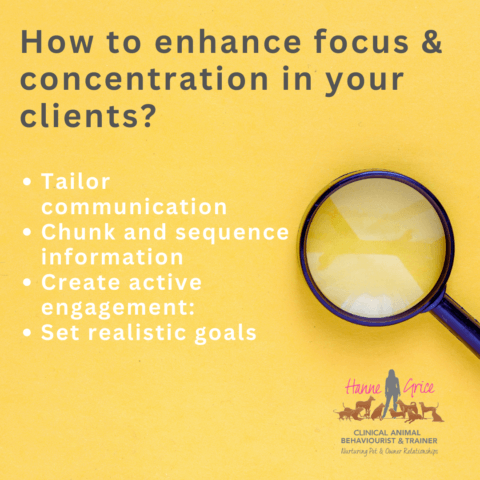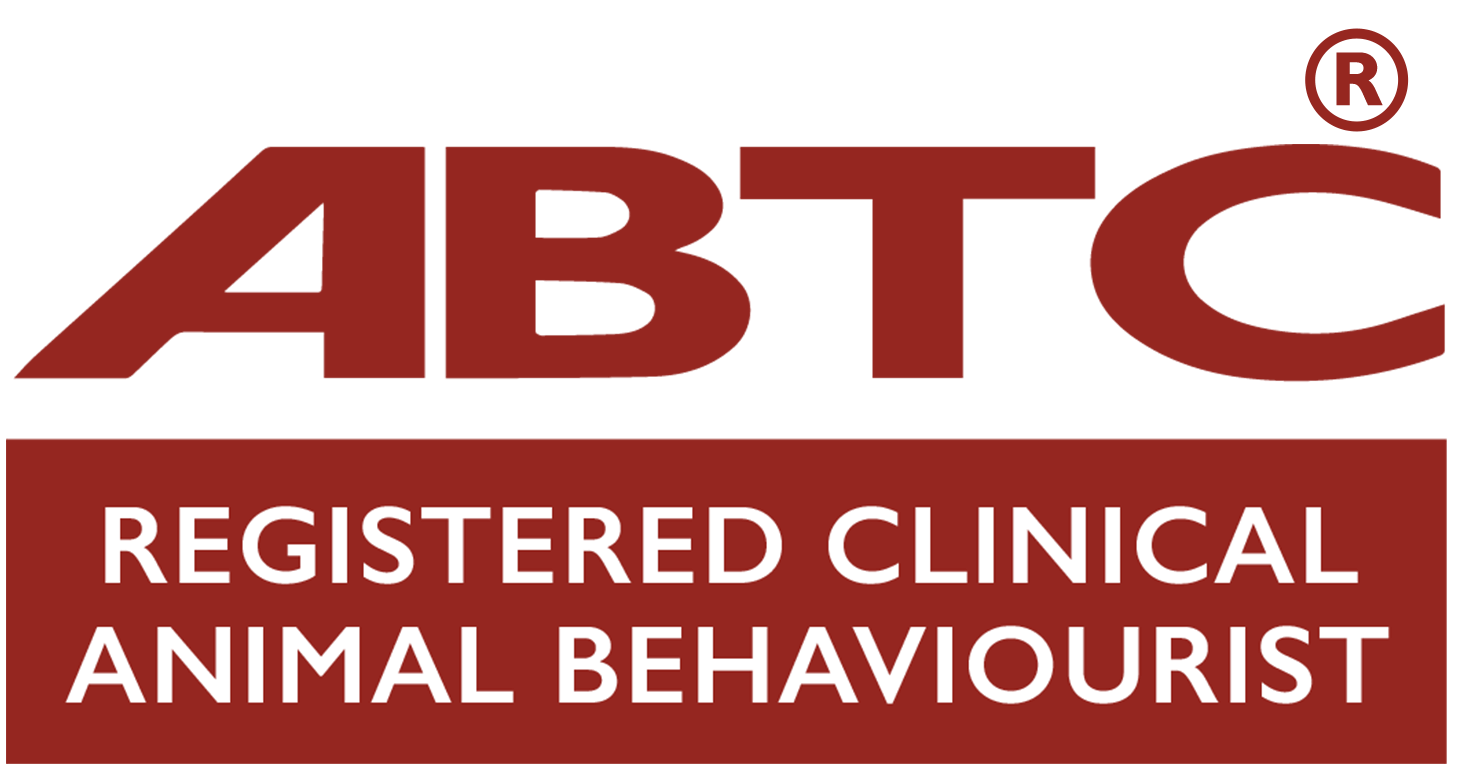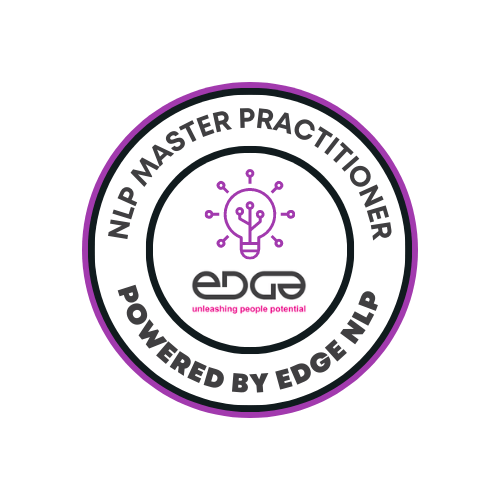This article is aimed at animal practitioners to help them better understand their clients, and improve the success of the training/behavioural plan.

The human brain is a remarkable organ that plays a crucial role in our ability to focus and concentrate. The ability to concentrate is not only relevant to human productivity but also holds practical implications for animal behaviourists in their consultations with clients. Understanding the dynamics of human attention and concentration can greatly influence the design of sessions and modification plans, ultimately making them more achievable and effective. This article explores the intricacies of the human brain’s ability to focus and concentrate and provides insights into how animal behaviourists can adapt their approach to better support their clients.
The Science of Focus and Concentration
At the heart of the brain’s ability to focus is the executive control network, a network of brain regions responsible for directing attention and suppressing distractions. This network enables individuals to selectively attend to specific stimuli while inhibiting irrelevant or competing information. However, the human brain is also susceptible to limited attentional resources and the influence of internal and external factors that can impair focus.
Factors Influencing Focus
- Cognitive Load: The brain’s capacity to process information is limited, and when overloaded with cognitive tasks, focus can diminish. Animal behaviour consultations often require clients to absorb new information and process complex behaviour modification plans, which can strain cognitive resources. Animal behaviourists can alleviate cognitive load by breaking down information into manageable chunks, delivering information over a series of sessions, and drip-feed via email, WhatsApp, plus providing step-by-step clear instructions, troubleshooting notes, access to your client membership site if you have one/or create one, using file sharing options such as Google Drive/Dropbox, as well as incorporating visual aids such as handouts, or written materials.
- Environmental Distractions: External factors such as noise, visual stimuli, or interruptions can disrupt concentration. Animal behaviourists can create a conducive consultation environment by minimising distractions, choosing quiet spaces, and setting clear boundaries to optimise client focus. Be confident to ask owners/caregivers to turn off the television or radio if you find such devices are on when you arrive for your session. Manage their expectations by explaining how the session will run and the estimated duration of the session – you may have already given this information via an email but remind them, as the client may have work to return to, a school run or another appointment to make that could distract if they are worrying about being late where they are unaware of timings.
- Emotional State: Emotional well-being influences cognitive performance. High levels of stress, anxiety, or fatigue can hinder concentration. This is particularly relevant to clients that may be experiencing problems where their pet is displaying aggressive responses (such as lunging, barking, growling, snapping etc) towards others. Animal behaviourists can promote a relaxed and supportive atmosphere during consultations, offering strategies for managing stress and incorporating regular breaks to enhance client engagement. Ensure you manage risk – before your consultations, complete your risk assessment not just focused on that appointment but for the broader case you are dealing with; consider all parties likely involved, associated legislation that needs to be considered, how to keep everyone safe, the physiological and psychological risks, and so on.
Enhancing Focus and Concentration
There are various ways we can enhance our clients’ focus and improve their concentration during any training or behaviour appointments.

- Tailored Communication: Recognising that each client has a unique attentional profile, animal behaviourists can adapt their communication style to accommodate individual needs. Some clients may require succinct instructions, while others may benefit from additional examples or visual demonstrations. Ensure you ask your client what is their preferred way to communicate any questions that may have with you throughout the process, and preferred ways to learn. Bear in mind some clients may have additional needs such as needing to ‘fiddle’ with something, be it their phone/a pen or something, as this may help them concentrate, whilst others may need to close their eyes or look away from you as they are recalling information or listening to new information. So, account for the individual. By tailoring your approach, behaviourists can enhance client understanding and engagement.
- Chunking and Sequencing: Breaking down complex information or behaviour modification plans into smaller, manageable segments can aid comprehension and retention. Ensure you include aims and objectives as this can create clarity and focus, provide a measurable outcome that can be used to evaluate progress and success, as well as enable accountability and allow for collaboration. By presenting information in a logical sequence and summarising key points throughout the consultation, this can reinforce client focus and help them grasp the overall objectives.
- Active Engagement: Incorporating interactive components, such as hands-on activities or guided practice, can boost client engagement and reinforce learning. Animal behaviourists can encourage clients to actively participate in demonstrations or provide feedback, fostering a sense of involvement and accountability.
- Setting Realistic Goals: Unrealistic expectations or overwhelming targets can lead to frustration and decreased motivation. Animal behaviourists should work collaboratively with clients to set achievable goals that align with their capabilities, resources and agreed objectives. Breaking larger goals into smaller milestones can provide clients with a sense of progress and accomplishment, enhancing their commitment to the behaviour modification plan.
Key take-aways
Understanding the human brain’s capacity to focus and concentrate is instrumental for animal behaviourists in facilitating successful consultations and behaviour modification plans. By acknowledging the limitations of attentional resources and incorporating strategies to optimise focus, animal behaviourists can empower their clients to make sessions more achievable and effective. Tailored communication, breaking down information, active engagement, and setting realistic goals are key approaches that can enhance client understanding, motivation, and cooperation.

By adapting their consultation techniques to align with the intricacies of human attention, animal behaviourists can pave the way for more successful outcomes in resolving animal behavioural challenges.
Want to learn more? Check out my Learning Hub. This includes Hanne’s independently assessed and recognised CPD course Human Behaviour Change for Animal Professionals course – aimed at animal professionals who want to develop their knowledge and understanding about human-animal interactions and improve the client-animal practitioner relationship, to increase the success of behaviour/training modification programmes and client cooperation.
References:
- Desimone, R., & Duncan, J. (1995). Neural mechanisms of selective visual attention. Annual Review of Neuroscience, 18, 193-222.
- Eysenck, M. W., & Derakshan, N. (2011). Cognitive control processes and attentional distraction in anxiety and depression. In M. J. Eysenck & D. Groome (Eds.), Cognitive psychology: A student’s handbook (6th ed., pp. 499-528). Psychology Press.
- Schmeichel, B. J., Volokhov, R. N., & Demaree, H. A. (2008). Working memory capacity and the self-regulation of emotional expression and experience. Journal of Personality and Social Psychology, 95(6), 1526-1540.
- Zimmer, H. D. (2010). Visual and spatial working memory: From boxes to networks. Neuroscience & Biobehavioral Reviews, 34(4), 475-483.
Learn more about our classes

Get Hanne's Book
Playing With Your Dog will help any dog owner work out the games that are best suited for their pet to play throughout his life, from puppyhood to old age. The book also shares some tricks for all ages, group activities, and recommended toys that dogs will enjoy.

























